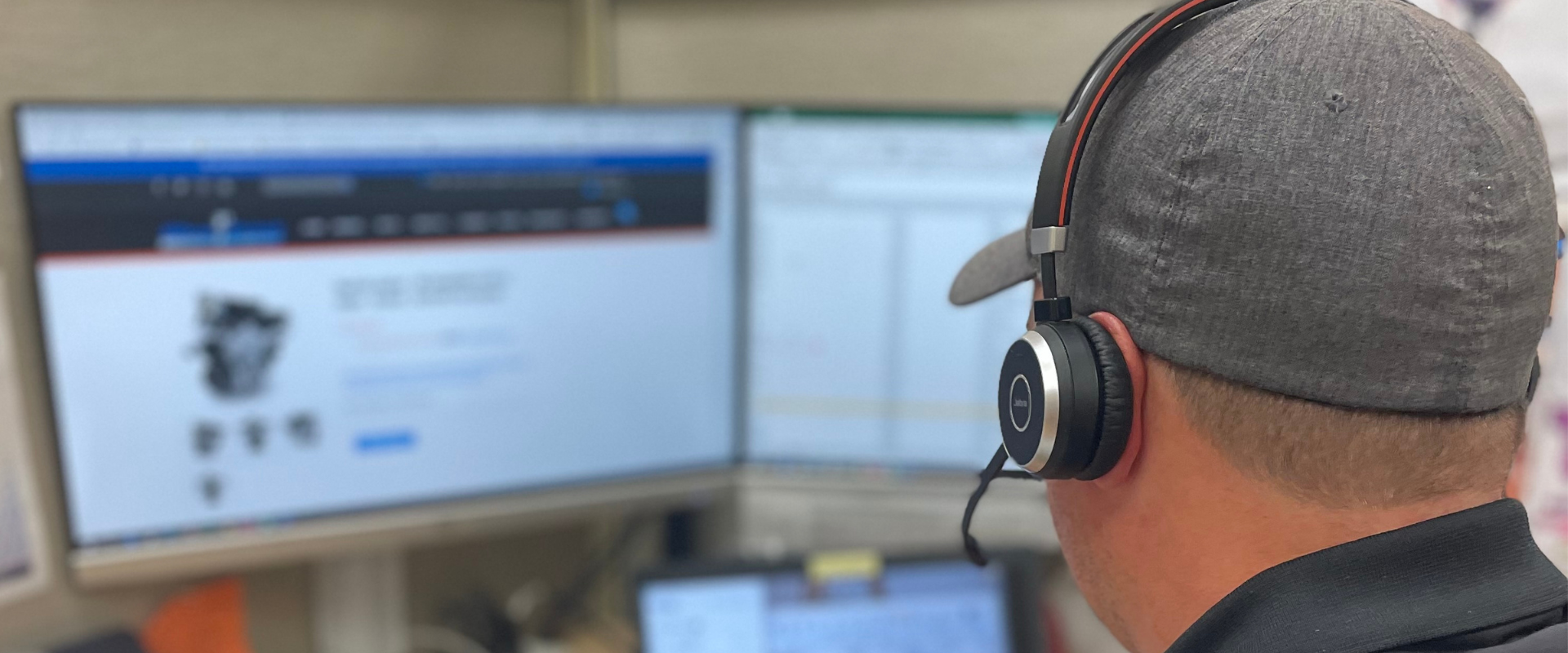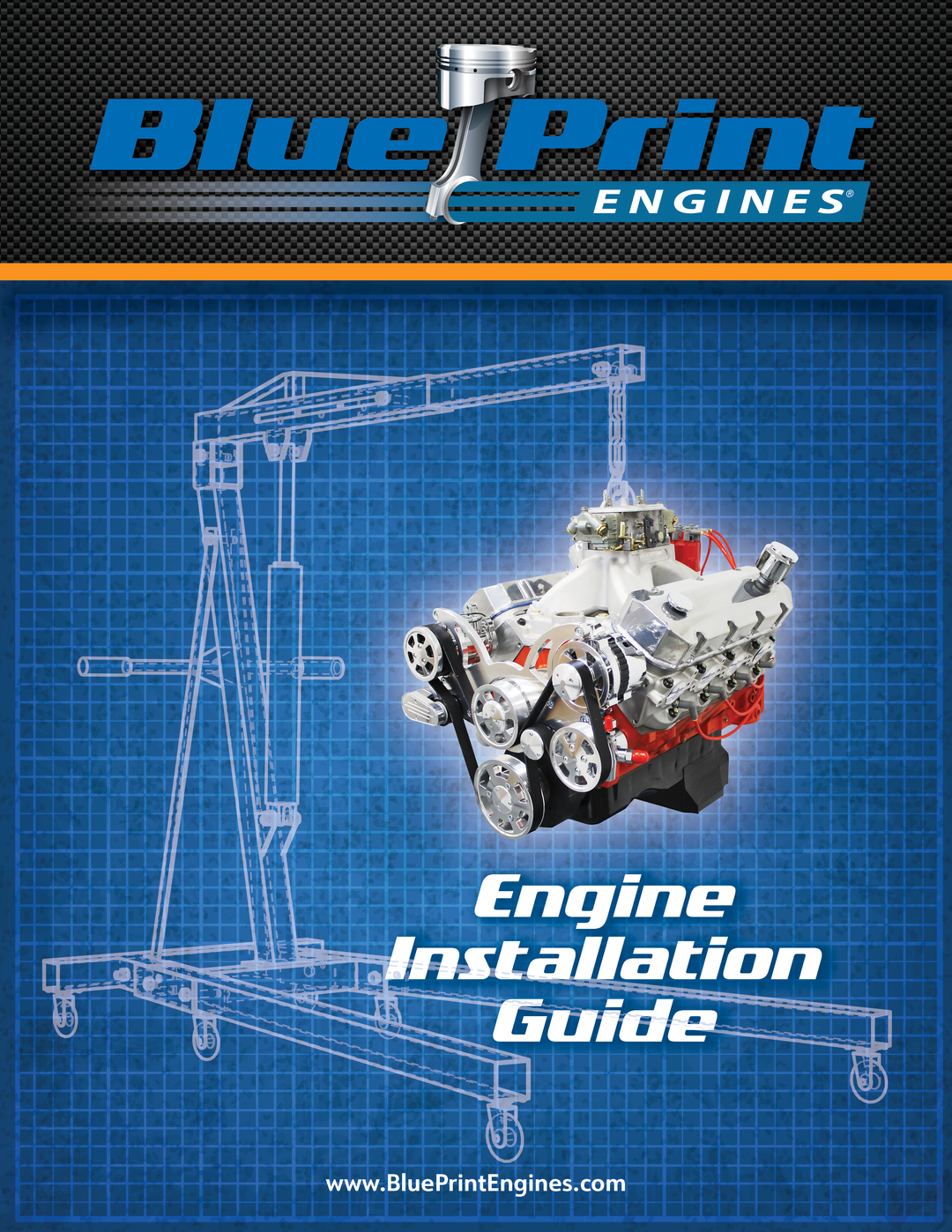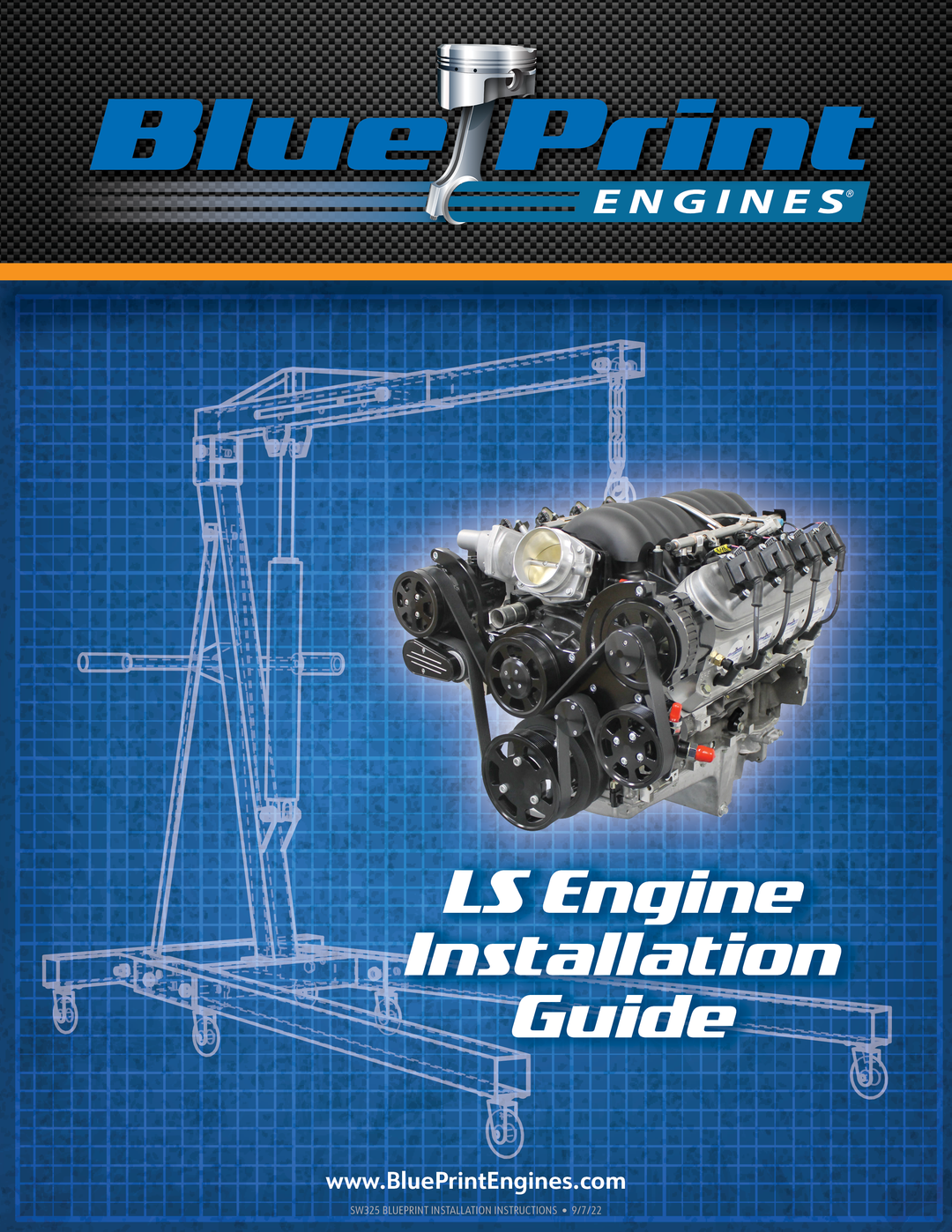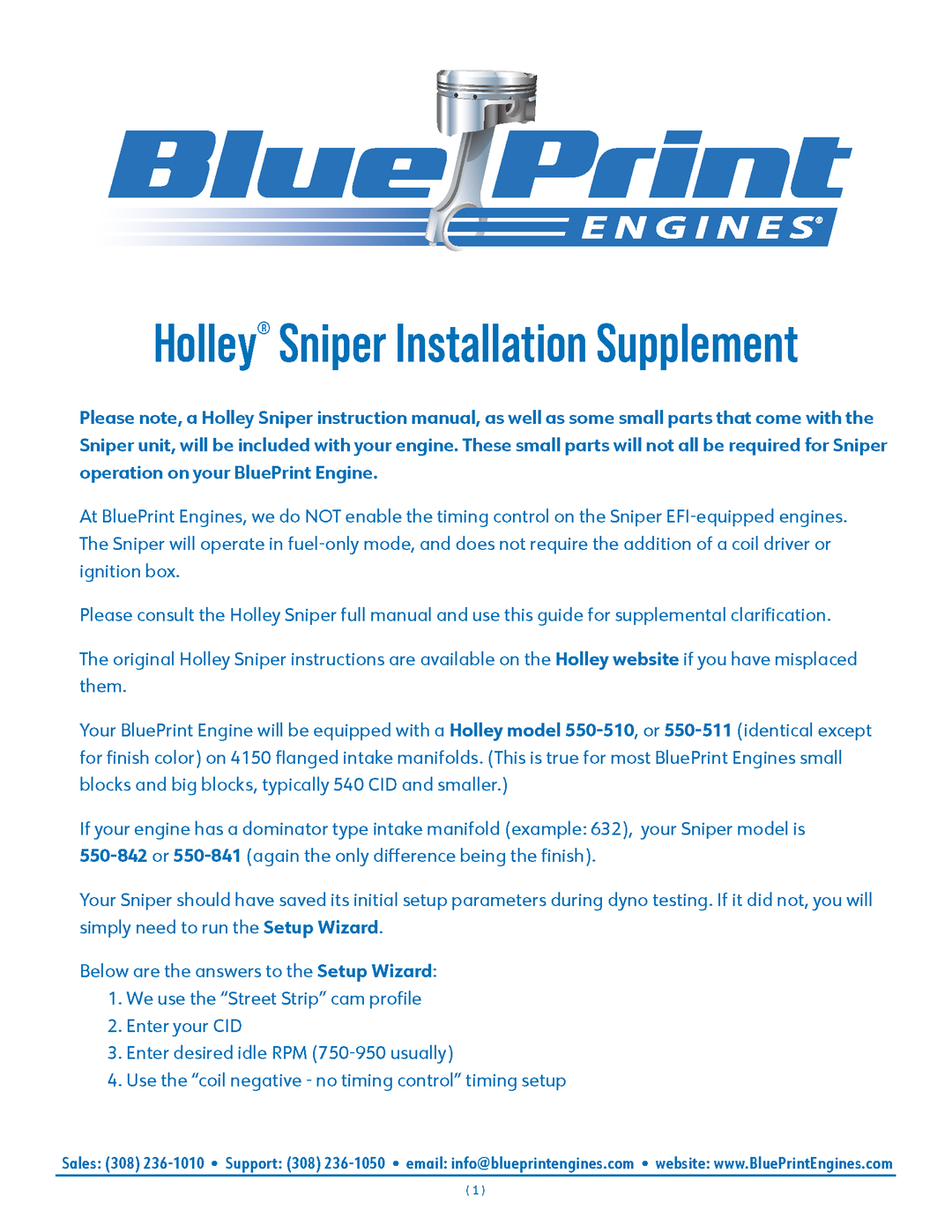With proper installation, break-in and maintenance, your new high-performance BluePrint crate engine will give you years of trouble-free performance.
Inside the Installation Guide you’ll find the information and instructions you need for proper installation, break-in and maintenance. All are necessary to ensure your BluePrint engine performs the way it was designed. After installation, remember to activate your BluePrint Engines 30-Month/50,000-Mile Limited Warranty by completing and submitting your warranty registration form online.
Tech Tips
The following tech tips are provided to help when purchasing a BluePrint crate engine and includes information on engine pre-lubrication, components and accessories, engine identifiers, and overall information to help with your installation and ongoing maintenance. If you have suggestions for topics, please share them with us and we'll add them to our growing list.
We are often asked what oil should be used in our BluePrint crate engines and to help our customers, we have created a special break-in engine oil for all crate engines!
CATEGORY:
Break-in, Lubrication
ISSUE:
BluePrint engines arrive ready to install. Because all crate engines have been dyno tested, the original assembly lube has been washed from the bearing surfaces and replaced with engine oil. However, oil is drained for shipping, so when your BluePrint engine arrives, the bearing surfaces are dry.
ACTION:
BluePrint Engines strongly recommends pre-lubing all Chevy, Chrysler, Ford crate engines as well as ProSeries™ engines and shortblocks before initial start up.
The recommended way to pre-lube your new blueprint engine is to remove the spark plugs and spin the engine over for several seconds to build up oil pressure and distribute oil throughout the engine.
This break in oil can be used for the first 500 miles, during the break in of your new crate engine. It has been specially formulated with the following benefits to break in your new engine and get you started with all the proper additives to ensure a long engine life. The benefits of our break-in oil are:
Increases high-temp film strength, oil pressure and compression at all RPM ranges. Designed to reduce potential engine failure during the break-in period. Provides high-temp viscosity and anti-wear control. Protects bearings at initial startup and at higher speed and temperature. Recommended for all types of engines: including flat tappet and roller camshafts. Requires no additional additives.
If you wanted to source oil locally for your crate engine, we just want to make sure you are using a good quality oil – we typically recommend a 10W30. Also, if you are running a flat tappet camshaft please make sure you are also using a separate zinc additive, in addition to your oil. Refrain from using synthetic oil for the first 9,000 miles on all BluePrint crate engines.
Roller Camshaft Engines:
BluePrint Part #BPP710 or a 10W30, non-synthetic oil. A zinc additive, or break-in oils are not necessary, but can be used.
Flat Tappet Camshaft Engines: BluePrint Part #BPP710 or a 10W30 with a separate zinc additive. One example would be Lucas Oil part number #10063
APPLICATION:
All BluePrint Chevy crate engines
All BluePrint Chrysler crate engines
All BluePrint Ford crate engines
All BluePrint Engines ProSeries Chevy stroker and Ford stroker engines
All BluePrint Engines short blocks
All BluePrint Engines marine engines
Purchase BluePrint Engines break in oil here or by giving us a call at 308-236-1050
One of the most frequently asked questions we get from BluePrint’s customers is about starters. Do I need a mini starter? Or, a high torque starter? Or, will my old starter work? There are several factors to consider before buying a new starter for your new BluePrint engine. We will cover them here.
First, let’s give you some information on what necessitates a performance starter over a stock replacement starter.
High compression engines:
Many race engines have compression ratios reaching 15:1, or more. This high amount of static compression puts much more pressure on the starter requiring more torque than a stock replacement starter is capable of producing. Nearly all of the BluePrint’s crate engines have compression of 10.3:1, or less. The 160 ft lbs of torque most factory starters are capable of producing are generally enough to turn engine sufficiently to get it started.
Timing:
Specifically, how much initial timing the engine has will make it harder for an engine to turn when starting. Many race engines have their ignition timing locked out at full advance in the 35-40 degree range. As such, many aftermarket ignition systems have timing retard switches built in that reduce the timing significantly during starting of the engine. BluePrint’s crate engines have recommended initial timing of 16 degrees or less which should not cause problems as well. Check your engine’s timing before purchasing a new starter.
Valve spring pressures:
Valve spring pressures also play a factor in the amount of torque necessary to turn the engine for starting. Engines built with solid roller camshafts need spring pressures that are at least 350 psi when the valve is closed to sometimes over 700 psi open. All that pressure requires much more torque exerted by the starter to turn the engine as well. BluePrint’s crate engines use hydraulic camshafts that need much less spring pressures for proper valve control. As such, the starter does not have to fight extreme spring pressures to turn the engine.
To decide whether or not to buy a new, expensive starter for your BluePrint crate engine, we have some questions that you should answer first:
- Did the starter that was on your old engine work fine? If so, go ahead and try it on the new engine before purchasing a new one.
- Whether you are using a factory starter, or a new, aftermarket one, having good quality battery cables is a must. Many hard starting problems are caused by battery cables that are too small, worn out, or getting too hot by their proximity to the heat of the exhaust. This is something that should always be checked first before buying a new starter. $20 for new battery cables is much cheaper than $100, and up, for a new starter. You want 2 gauge minimum on both the positive and negative battery cables. Also, the engine must have ground straps to the frame of the vehicle to prevent hard starting problems.
- Do you have limited room for a big, factory type starter in your project vehicle? Space limitations will often dictate the necessity of a mini starter. Also, tubular exhaust headers can also make the use of factory starters impossible from either lack of space, or heat soaking the starter.
Ford and Chrysler's starters bolt directly to the transmission bell housing. Chevrolet starters bolt to the engine block itself. These Chevy starters have either a straight across the pattern or the staggered pattern. Many customers ask us what BluePrint’s crate engines are drilled for. All of our Chevy engines are drilled and tapped for both the straight and staggered starter bolt patterns.
Customers often ask us how to tell the difference between factory high torque starters and the standard versions. On Chevy engines, this is easily visible by looking at the starter itself. You may not need to remove the starter to see this.
GM factory starters have a ground strap that comes out of the main body of the starter and connects to the solenoid by a copper spacer. High torque starters will have about a 1 inch long copper spacer. Standard, non-high torque, starters will only have a ¼” spacer or less. See the pictures below to see the difference between the two versions.
If you have any additional questions you need answered on starters for your BluePrint crate engine, please contact us at info@blueprintengines.com, or call us at 308-236-1050
BluePrint Engines high performance engines have been "stroked" to increase displacement and power. However, these engines use standard sized engine blocks for easy bolt-in installation.
Chevy 350 block has been stroked to 383 cubic inches or 396 cubic inches.
Chevy 454 block has been stroked to 496 cubic inches.
CATEGORY:
Information, Applications
ISSUE:
BluePrint Engines do not use familiar engine displacements (350 and 454 cubic inch) to specify Chevy applications. Instead, these engines are listed with their "stroked" displacement.
ACTION:
When selecting a Chevrolet engine application, use the following:
Original Chevy block application: 350 c.i.
BluePrint Engines Stroker displacement: 383 c.i. or 396 c.i.
Original Chevy block application: 454 c.i.
BluePrint Engines Stroker displacement: 496 c.i.
APPLICATION:
All BluePrint Chevy crate engines
All BluePrint Engines ProSeries Chevy stroker engines
All BluePrint Engines Chevy short blocks
BluePrint Engines high performance engines have been "stroked" to increase displacement and power. However, these engines use standard sized engine blocks for easy bolt-in installation.
Ford 302 block has been stroked to 331 cubic inches or 347 cubic inches.
Ford 351 Windsor block has been stroked to 408 cubic inches or 427 cubic inches.
CATEGORY:
Information, Applications
ISSUE:
BluePrint Engines do not use familiar engine displacements (302 and 351 cubic inch) to specify Ford applications. Instead, these engines are listed with their "stroked" displacement.
ACTION:
When selecting a Ford engine application, use the following:
Original Ford block application: 302 c.i.
BluePrint Engines Stroker displacement: 331 c.i. or 408 c.i.
Original Ford block application: 351 c.i. Windsor
BluePrint Engines Stroker displacement: 408 c.i. or 427 c.i.
APPLICATION:
All BluePrint Ford crate engines
All BluePrint Engines ProSeries Ford stroker engines
All BluePrint Engines Ford short blocks
BPP51061 - SBC/BBC Engines
BPP51515 - SBF and Chrysler Engines
BPPB160 - LS Style Engines
HERE ARE SOME OTHER HIGH QUALITY OIL FILTERS WE RECOMMEND AND WHICH ENGINE FAMILY THEY FIT ON:
GM Small Block and Big Block:
Baldwin B6 - Wix 51061 - Napa 1061 - K&N HP3002 - AC Delco PF1218
GM LS:
Napa 7060 - Wix 57060 - K&N HP1017 - AC Delco PF48E
Ford Small Block & Chrysler Big and Small Block:
Baldwin B2 - Wix 51515 - Napa 1515 - K&N HP3001 - AC Delco PF2
At BluePrint Engines,we realize how important it is to find parts that will fit your new engine! With headers, it’s crucial to understand that most aftermarket cylinder heads are designed for both performance and efficiency. For this reason, BluePrint Engines cylinder heads (and most other aftermarket aluminum heads) are NOT direct clones of OEM iron heads. If they were, they would not make the horsepower we have come to know and love. However, many aftermarket headers are designed primarily around stock vehicles with stock heads. There are many “off-the-shelf ” headers that do work, but with the countless manufacturer SKU’s out there, we cannot guarantee every header fits our engines.
For this reason, we have partnered with the header manufacturers below and shipped them our head castings so they can help you directly and confirm header fitment for your new BluePrint Engine in your specific vehicle.
Please contact these companies DIRECTLY and let them know you have a BluePrint Engine before ordering!
DO NOT assume that every part number from these companies will work for your application. You MUST CONTACT THEM DIRECTLY and make it known you have a BLUEPRINT ENGINE!
Hedman HUSLER Race Headers
730 Branch Drive
Alpharetta, GA 30004
770-664-8880
Hedman HUSLER is a longtime manufacturer of headers for performance applications with aftermarket heads. They have numberous options for BluePrint Engines’ BBC, SBC, SBF, LS, and SB Mopar offerings. It’s EXTREMELY important you contact their HUSLER office in GA, as that branch handles the headers for BluePrint. Do NOT contact the CA office (which handles stock headers ). They also carry a complete line of LS engine swap brackets and headers.
Sanderson Headers
517 Railroad Ave
South San Francisco, CA 94080
650-583-4590
Sanderson Headers primarily offers shorty and mid length headers, with some long tube offerings. They also have offerings for SBC, BBC, SBF, and Mopar . They have our head castings to confirm fitment if you contact them directly.
Lemons Race Headers
1008 18th St Unit #1
Paso Robles, CA 93446
805-239-8998
Lemons has both our BBC and SBC head castings to build headers to suit. They have primarily sold headers to BluePrint Engines’ 632 customers but can also do BluePrint SBC on certain applications. Supports BBC and SBC only.
Ultimate Headers
82 Helwig St.
Berea, OH 44017
440-234-9600
Ultimate Headers offers a complete line of premium stainless steel headers for all BluePrint Engines. In addition to their extensive catalog of known vehicle fitments, they have the ability to ship a header, tach welded together to you for trial fitment, ensuring proper fit for new applications!
BluePrint Engines recommends the use of performance exhaust gaskets on all of our performance engines. DO NOT use the stock replacement type exhaust manifold gaskets. These are designed for original iron heads with iron exhaust manifold use only.
They will not seal when headers are used. This is especially true when the engine has aluminum heads with headers. The stock type gaskets will blow out very quickly and cause exhaust leaks. This can eventually cause engine failure that would not be covered under our warranty.
EXTREME IMPORTANCE FOR AFTERMARKET EFI SYSTEMS
This is extremely important when using aftermarket EFI systems. They rely heavily on an accurate air/fuel mixture reading that is constantly monitored by their wideband Oxygen, or O2, sensors.
An exhaust leak can cause a false “lean” condition by allowing unwanted oxygen into the exhaust stream. Once the O2 sensor detects this lean condition, it will adjust the air/fuel ratio to a richer mixture to compensate for the lean condition it is reading. Typically, the first signs of this problem will be fouled spark plugs, and/or a poorly running engine.
RECOMMENDED HEADER GASKETS
The first thing to remember is that you should always use header gaskets that match the shape of tube design on the header flanges. DO NOT use header gaskets to match the exhaust ports. Failure to do this will cause header leaks. Headers do not have to match the shape of the exhaust ports. On a street engine operating from idle to 6,000 rpm, you will not lose any horsepower.
BluePrint Engines recommends several different types of header gaskets.
Perforated steel core laminate type from Fel-Pro and Mr. Gasket.
MLS, multi-layer steel from Percy’s and Kook’s. Copper gaskets from Cometic, SCE, Mr. Gasket, Summit Racing brand, and other brands.
INSTALLATION TIPS
Prior to installing your headers, verify that they are not warped. There is not a header gasket that will cure a warped header flange. Be sure to thoroughly clean all old gasket material before installing headers with new gaskets. Most exhaust gasket failures are caused by header bolts loosening and/or the gasket relaxing after several heat cycles. To help prevent this, replace old header bolts with the locking style bolts.
3/8” exhaust bolts are torqued to 25 ft lbs. 5/16” torque to 18 ft lbs. Use anti-seize on the bolt threads before installing the bolts. Recheck torque on all exhaust bolts after the first 50 miles, and again after 500 miles. Re-torque as needed.
LOCATING EXHAUST LEAKS AT THE CYLINDER HEADS
Often times exhaust leaks are small enough that they are often hard to hear when the engine is idling. They will also sound very much like a lifter ticking or a valve out of adjustment. Some can only be audible when the engine is under load.
While a mechanic’s stethoscope can be used to locate many engine noises, they do not work as well for finding an exhaust leak. Since exhaust leaks are just air leaks, locating the source of the leak can be accomplished very easily by using a 2 or 3-foot length of vacuum line as a stethoscope.
With one end held up near the ear, move the other end of the hose around the edge of the header flange, or exhaust manifold as this is where leaks are the most common. The minor exhaust leak will be easily heard and you will be able to locate the source of the leak within a square inch. If you cannot locate the source of the leak at the header flange, then check around the collector to exhaust pipe location.
Over time, headers can start to leak where the four primary pipes are welded into the collector. Once the source of the exhaust leak is found, follow the steps previously explained in order to remedy the problem.
BluePrint Engines CTF Engines
Q: Is the Holley Sniper utilized by BluePrint engines on our CTF engines the same one Holley is selling, with the same features?
A: Yes. The Sniper is unchanged from the way it comes delivered from Holley. Customers receive the handheld unit, and everything that would come in the box from Holley as normal.
Q: Do the CTF engines come with a fuel pump?
A: No. Fuel injected engines on Blueprintengines.com do not include EFI fuel pumps.
Q: Do you sell an EFI rated fuel pump?
A: Yes
Q: On the CTF engines, are we utilizing the timing control feature.
A: NO! every engine that is being offered with the sniper is utilizing an HEI, or a ready to run distributor. The sniper can operate just fine in “fuel only” mode, and let the weights and springs in the distributor control timing, just as they would with a carb.
Q: Will you build me an engine with timing control?
A: Not at this time. “Fuel only” mode simplifies setup, function, and reduces troubleshooting for our customers.
Q: What do I do if I absolutely want timing control?
A: Although we do not offer our engines with timing control, we do NOT disable anything within the Sniper. The sniper is still capable of controlling timing if you purchase a compatible BluePrint distributor, and phasable rotor. We cannot swap out non-compatible distributors for compatible ones, but pro series distributors, are available through BluePrint Engines if you wish to make the conversion yourself. We recommend you have a working understanding of setting up the timing control functions on your own. We also feel the fuel only operation of the Sniper is fully adequate, but realize some customers may want to utilize it.
Another option is to buy one of our Dyno-tested “CT” long block engines, and purchase a Sniper From BluePrint with your CT. The parts to install your Sniper, and complete your engine, are all available through BluePrint Engines, Via the Parts tab on our website, or your sales rep.
Q: Do I need an Oxygen sensor?
A: YES! and it's included with the kits and is 100% necessary for the engine to run properly.
Q: What do I need to know about Oxygen Sensor placement?
A: The sensor must be located 18 inches or more from the exit of the tail pipe. This ensures no back-feeding air is coming in the tail pipes, and disrupting the O2 sensor reading. We also recommend the sensor be 6-10 inches from the collector, so the sensor can read all cylinders on the exhaust bank.
Q: Do I need to install the Oxygen sensor before I start my engine, even just to test fire or move the car?
A: YES! The sensor is 100% necessary for the engine to run properly, even just to move the car, or to test fire the engine. Dangling your O2 sensor in front of an open header, or any other configuration other than installing it into a bung, with the above requirements, will result in an extremely rich mixture, fouled plugs, and poor running, or no-start issues. https://blueprintengines.com/collections/efi-kits






